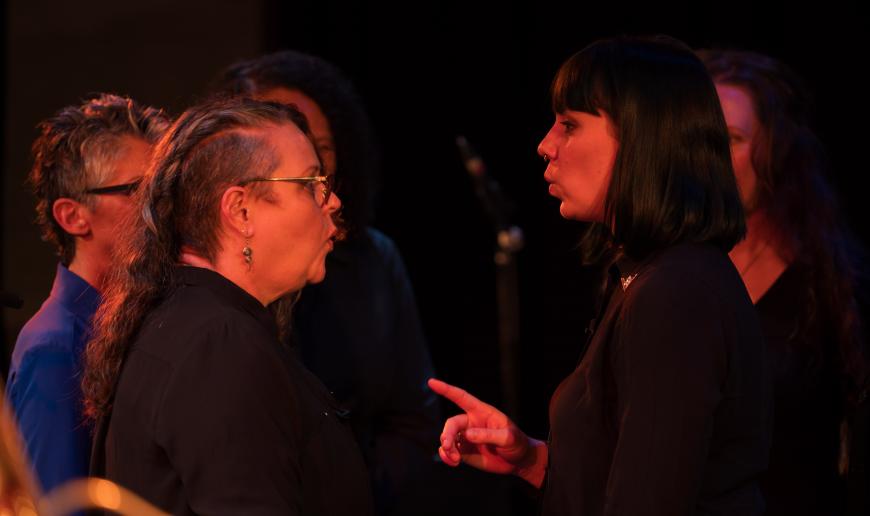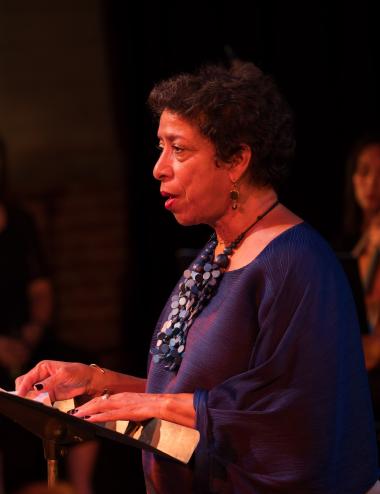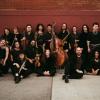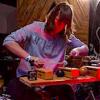
Judging by the enthusiasm of the capacity crowd that gathered on Sunday at 2220 Arts + Archives to hear a performance by Wild Up, momentum for the California Festival, which kicked off on Nov. 3, is growing. Buzz in the lobby was all about which concerts people had already been to, their anticipation for the concert they were about to hear, and the next concerts they were planning to attend.
As announced from the stage by Wild Up’s founder and artistic director, Christopher Rountree, the 60-minute piece the group was about to perform, We’re Here! What Now?, is in its workshop phase. It brings together a unique group of female collaborators: composer Sarah Hennies, 2021–2022 Los Angeles Poet Laureate Lynne Thompson, and the interdisciplinary artist Susan Silton and her six-member female whistling ensemble, The Crowing Hens.
According to the program notes, “The project takes inspiration from a family whistle — used to gather family in public — passed down to Silton through multiple generations by her father, whose family fled Nazi Europe in 1938. The work is also posited as future-forward: how do we as women — queer, trans, lesbian, cisgender, BIPOC [Black, Indigenous, people of color] — pick up the pieces of loss, dwell in it, activate it, resist against it, whistle a different tune?”

After experiencing We’re Here! What Now?, it’s clear Lauren Bacall did not understand there’s a lot more to whistling than “just put your lips together and blow.” The virtuosic dexterity of six professional whistlers combined with the complex instrumental constructions of Hennies’s composition made for fascinating results.
Thompson began with a poem, “We were Queens,” and then the whistlers joined Rountree and 12 members of Wild Up onstage. The individual whistles and their coming-together harmonies hovered in the air like so many ice crystals.
Hennies’s orchestration is divided into high-, middle-, and low-register sonorities accentuated by a two-man battery of struck and bowed percussion instruments that clang, clatter, rumble, purr, and pulse.
The score requires the musicians to literally be on the clock, all of them armed with stopwatches and specific timings designating their entrances. As Rountree later explained, much of the time the piece asks him to sit and listen, giving finger prompts indicating places in the score and entrances. And while these entrances are specifically notated, the expression of the passage, its intensity of attack, and potential for lyricism is improvised.

Over the course of two movements (separated by a lengthy poetic interlude from Thompson), the fabric of the work is simultaneously tightly knit, atmospheric, spare, and glassine, building to a genuine Big Bang in the percussion.
A similar sense of gradually coming together is represented by the six whistlers, whose icy formative phrases become more and more birdlike until they gradually evolve into a sense of human tribal ritual melody — was that a fragment from “Yankee Doodle”?
At times, Hennies’s music evoked the detailing of Morton Feldman, the minimalism of Alvin Lucier, and the atmospheric tidal shifts of John Luther Adams. There is also a wonderful section in the first movement when the strings and winds ascend in a series of ever-rising notes, like an atonal equivalent of Ralph Vaughan Williams’s The Lark Ascending.
For their part, The Crowing Hens (Erin Barnes, Jessica Basta, Carole Anne Kaufman, Laura Loftsgaarden, Kathryn Nockels, and Silton) offered a virtuosic study in whistling techniques and harmonies, all without the aid of a score. Their means for sound production varied from facial muscles and tongue and breath control to the two- and three-finger style that could stop a New York cab in its tracks.
In a post-performance Q&A, the creators were asked about the decision to isolate the poems entirely from the music. Thompson admitted the separation perplexed her. She had initially assumed the poems and the music would be interpolated. But when she asked her collaborators whether it might be useful for her to hear the music in advance, they said it wasn’t necessary.
That style of chance creation may have suited John Cage and Merce Cunningham. And while Hennies and Silton said they heard a wonderful sense of connection between the music and the poems, to my ear the associations were far from clear and meaningful. If this is indeed a work in progress, it might be worth experimenting with layering the music and the words. It might also offer Thompson the opportunity to add an expanded vocabulary of inflections and colorations to her recitations.




